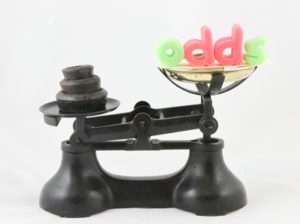 Anyone playing poker is vulnerable to becoming short-stacked, no matter what level of skill you possess. In fact, some forms of poker are inherently short-stack based and demand a different set of skills to more traditional Texas Hold’em. Either way, if you’re playing poker, there will come a time when you find yourself short-stacked and in need of a plan (or at least some guidance on how to approach the game from there on out).
Anyone playing poker is vulnerable to becoming short-stacked, no matter what level of skill you possess. In fact, some forms of poker are inherently short-stack based and demand a different set of skills to more traditional Texas Hold’em. Either way, if you’re playing poker, there will come a time when you find yourself short-stacked and in need of a plan (or at least some guidance on how to approach the game from there on out).
The following article will delve deeper into what exactly it means to be ‘short-stacked’ and how you can adapt your strategy to remain in the game and improve your chances of ultimately winning. The advice below will provide some insight into short-stack play and what your opponents may be thinking in certain situations as well as some brief examples on when you may choose to perform certain plays.
What is a ‘Short Stack’?
 In poker, the term ‘stack’ refers to the number of chips you have. Specifically, your stack size is affected by the number of chips you have in relation to the current blind. Many people think of short stacks as being the player or players with the fewest chips, but all players can be short-stacked if the blinds are sufficiently high in comparison to their chip totals.
In poker, the term ‘stack’ refers to the number of chips you have. Specifically, your stack size is affected by the number of chips you have in relation to the current blind. Many people think of short stacks as being the player or players with the fewest chips, but all players can be short-stacked if the blinds are sufficiently high in comparison to their chip totals.
There are four different stack size categories, each defined by how many big blinds’ worth of chips a player has:
- Short-Stack – Usually less than 40 big blinds
- Mid-Stack – Usually 40-80 big blinds
- Full-Stack – Usually 80-150 big blinds
- Deep-Stack – Usually 150+ big blinds
With each stack size, comes a different strategic approach. Simply put, the fewer chips you have, the heavier the focus on pre-flop play. And as such, the larger your stack, the more important post-flop play becomes.
Short-stack play limits your options like no other stack size, which is obviously a disadvantage. However, there are ways to turn a seemingly bad situation on its head by using your situation to your advantage. Players will react differently to your plays, so it’s important to remain perceptive and flexible if a certain approach isn’t working out.
Do Not Opt To Be Short-Stacked
 Given the fact that having fewer chips is akin to losing, this may seem like an obvious suggestion. However, some people may favour short-stacked strategies due to the focus on pre-flop play and, as a result, counterintuitively feel more comfortable when they have fewer chips. Nevertheless, being short-stacked isn’t ideal, so in games where you have the opportunity to buy in for less than the maximum, it’s advisable not to.
Given the fact that having fewer chips is akin to losing, this may seem like an obvious suggestion. However, some people may favour short-stacked strategies due to the focus on pre-flop play and, as a result, counterintuitively feel more comfortable when they have fewer chips. Nevertheless, being short-stacked isn’t ideal, so in games where you have the opportunity to buy in for less than the maximum, it’s advisable not to.
Having fewer chips than your opponents puts you at an instant disadvantage when it comes to beating each opponent. Being short-stacked limits your options, which may sound nice for novices, but ultimately, can put you in a difficult spot where you cannot make optimal plays. Having a larger stack allows you to take advantage of certain situations and maximise your winnings, whereas short-stacked players can often be forced into all-or-nothing calls.
Being short-stacked is by no means the end of the world (as we’ll explain below) but given the choice, more chips are better than fewer. Being most comfortable with the strategies of short-stack play is not reason enough to willingly put yourself in a position where the strongest players could force you into a corner if you aren’t careful.
Tighten Up Your Play
 If you do find yourself in a short-stacked situation, it is far from ‘game over’ for you. However, every choice you make gains more importance as your stack dwindles further. For this reason, the pre-flop strategy becomes essential.
If you do find yourself in a short-stacked situation, it is far from ‘game over’ for you. However, every choice you make gains more importance as your stack dwindles further. For this reason, the pre-flop strategy becomes essential.
As your stack shortens, your range of playable cards also shrinks. Short-stacked players should be looking to tighten up their game, sticking to the strongest of hands. For some players, this is an art rather than a skill, but no player will be consistently successful in the long run unless they have a consistent strategy when it comes to tightening up their play.
Playing with a 9♦ 8♦ might be a sensible hand earlier in the game when your stack is healthy, but when the number of hands you can play in are numbered, and you’re up against a deep stack, they may well chance their arm with a weaker pre-flop hand, leaving you committed to the pot and unsure on what exactly you are going to do next.
Whereas, if you have successfully tightened up your game, when a K♦ K♥ rolls around, you can feel relatively confident if raised pre-flop.
Understand Preflop Ranges
 Building on from tightening up your play, understanding preflop ranges are vital to do this effectively. It’s all well and good knowing that K♦ K♥ is likely better than 9♦ 8♦ should things go to showdown, but having the knowledge to make consistent, statistically-backed calls is a useful skill to have.
Building on from tightening up your play, understanding preflop ranges are vital to do this effectively. It’s all well and good knowing that K♦ K♥ is likely better than 9♦ 8♦ should things go to showdown, but having the knowledge to make consistent, statistically-backed calls is a useful skill to have.
There is no shortage of useful resources showcasing preflop range suggestions and displaying accurate data. Consulting these can help you to make informed decisions, and committing some of this information to memory will give you the tools you need to make logical and consistent decisions. Certain resources will go into great depth, suggesting not only when you might choose to play, but how you might approach a situation.
It’s important not to get sucked into the useful resources, however. They are great as guides, but they shouldn’t be blindly followed. The actions of your opponents have to be taken into account, and your ranges need to adjust depending on their play. If the rest of your table is playing extremely tightly, you can afford to be a bit looser. Conversely, if your table is particularly loose, you’ll want to tighten up that bit more to avoid disappointment.
Preflop ranges are a good starting point but there is certainly some room for deviation when the situation calls for it.
Take Note of Effective Stack Size
 When playing short-stacked, it isn’t just your stack size that has to be taken into account. Effective stack size is affected by the size of your opponents’ stack sizes and should influence your actions and raise sizes. Being able to decide when to adjust based on effective stack size will give you an added edge.
When playing short-stacked, it isn’t just your stack size that has to be taken into account. Effective stack size is affected by the size of your opponents’ stack sizes and should influence your actions and raise sizes. Being able to decide when to adjust based on effective stack size will give you an added edge.
The effective stack is determined by the amount the shortest stack involved in a hand has. Surplus chips from the rest of the table become irrelevant for that hand, making the effective stack size the value of the shortest stack’s chips.
The concept of effective stack size is important for a couple of reasons:
- Defining the maximum amount that can be won from a hand – the smaller the effective stack, the less that can be won.
- Reducing your fold equity – the smaller the effective stack, the fewer players have to lose, and as a result, the more likely they are to call a bluff.
Think About Postflops
 The majority of play will take place preflop when short-stacked, but it’s important not to focus entirely on preflop play. On occasions when you see the flops a short stack, your options will be very limited, and more often than not, you may be forced all-in. As such, it’s important to weigh up this situation ahead of time.
The majority of play will take place preflop when short-stacked, but it’s important not to focus entirely on preflop play. On occasions when you see the flops a short stack, your options will be very limited, and more often than not, you may be forced all-in. As such, it’s important to weigh up this situation ahead of time.
If you have a hand that suits a raise preflop but doesn’t necessarily play well postflop, you may be best served raising higher initially. Conversely, if your hand has potential postflop, you may be more comfortable should the situation arise.
Be Careful with All-Ins
 Following on from this, it’s important to limit the number of times you go big preflop. Shoving all in at every opportunity may work to begin with, as other players back off, but doing so consistently is unlikely to work well in the long run.
Following on from this, it’s important to limit the number of times you go big preflop. Shoving all in at every opportunity may work to begin with, as other players back off, but doing so consistently is unlikely to work well in the long run.
Too many all-ins will quickly register with other players who will assume you’re doing so on weakened hands. Whether that’s true or not, the likelihood of someone calling you out on a bluff, especially as the short-stack, will increase rapidly.
Additionally, you may be picking up some easy wins, but going all-in and stealing blinds is unlikely to do much to your overall stack unless you’re severely short. And in cases where you’re that short, don’t be surprised if someone calls the relatively small raise with nothing special, just on the off-chance it comes up trumps.
Instead, it’s worth sticking to standard-sized raises wherever possible and folding when your hand is weak, or you’re expecting a raise. Like this, your stack can be saved for more opportune moments and the strongest of hands.
Don’t be Fearful
 When you find yourself as the short stack, it can be easy to become paralysed with fear. This might sound excessive, but it’s not far from the truth for many players. Noticing their stack is low, some players will freeze up and become far too passive, waiting for the perfect hand to be dealt before taking action.
When you find yourself as the short stack, it can be easy to become paralysed with fear. This might sound excessive, but it’s not far from the truth for many players. Noticing their stack is low, some players will freeze up and become far too passive, waiting for the perfect hand to be dealt before taking action.
There’s nothing wrong with a bit of patience, but the danger of waiting on that premium hand to bail you out is that those blinds will begin to chip away at your already short stack. Constantly folding also communicates your fear to other players who may become more loose, knowing that you’ll almost certainly give in.
This isn’t to say that playing tight is a poor strategy is a short stack – far from it – but taking this too far will be counterproductive as you continue to surrender your blinds and move in the wrong direction.
The counter to this is not to play hands for the sake of it. Limping in on the button can see you lose chips without necessity if players cotton on that you’re doing so with weak hands.
Playing with intention is the antidote to both these traps. Look to choose your moments carefully and play with purpose. This includes defending your blinds with a larger range of hands to prevent leaking chips and slowly heading towards the all-in territory.
Variance is inevitable
 Even the most calculated of players will encounter variance. This is brought more sharply into focus when you’re short-stacked and your decisions become more limited and your hands are forced.
Even the most calculated of players will encounter variance. This is brought more sharply into focus when you’re short-stacked and your decisions become more limited and your hands are forced.
Bad beats are part of the poker parcel, so even if you wait for that perfect moment to double-up with AA, your opponent may well incorrectly call your bluff with some middle-of-the-road hand only to see a two pair on the river – it happens.
The best way to combat this is to avoid getting into a short-stacked scenario in the first place (see the first suggestion) and employ the other strategies mentioned in this article should you find yourself short regardless.
Short stacked formats of poker will need more buy-ins to account for high variance. This is an important thing to note before committing to playing things like hyper-turbos and spin-and-go poker.
Conclusion

Even the very best are always learning in poker. There are plenty of things you can do to improve your short stack game, with even more situational variants and nuanced approaches available to use as you become more adept.
Time invested in studying short stack plays isn’t time wasted and will better equip you for a variety of situations you may find yourself in. Ultimately, these insights can help give you the edge and boost your chances of getting back into a game and coming out on top.
The best way to improve your short stack game is through experience. Implementing your newfound knowledge and strategies and seeing how they play out in a real-world scenario is the best way to further your understanding and improve your overall game.
There are 1000s of different scenarios that could play out, so remember to bear the concept of variance in mind and stick to your plan. Do not let emotions dictate your play, causing you to deviate from the research and information you’ve gathered. If you find yourself consistently losing out, then revaluating your approach and conducting further research before tweaking your strategy is the way to go.
